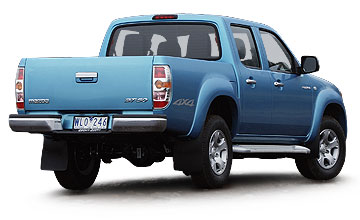BY PHILIP LORD | 22nd Dec 2008

The BT-50 arrived in 2006, but shares most of its underpinnings and hardpoint measurements with its predecessor, the B-Series ute. But that’s not to say the BT-50 is the tired old soldier of the one-tonne ute market.
It would be fair to say the Nissan D22 Navara and Mahindra Pik-Up are less advanced designs and that the 4WD ute market is not the picture of sophistication anyway. You won’t find five-star safety, side curtain airbags ESP or traction control on any of them, but at least some now have five lap/sash seat belts, while the BT-50 only has four.
The BT-50 displayed the sort of changes that enthusiasts delight in picking up but anyone else may struggle to notice. So, just for the record, the ‘new’ BT-50 has the Mazda five-point grille, revised headlights and tail-lights, a B-pillar body colour change on Freestyle Cab and Dual Cab, new wheel design (in both 15-inch and 16-inch), new interior cloth trim and new audio and ventilation controls.
Standard equipment in all BT-50s now includes air-conditioning and an auxiliary audio jack, but Mazda still has not been able to persuade the Thai factory to engineer and install cruise control to the BT-50, and there is no tray liner in the back, even though most of the top-shelf model competitors now have one fitted.
Inside, Mazda has done a good renovation job on the old B-series architecture. The dash and centre stack are well designed, with large, easy to find controls, and the ergonomics do not present any major difficulties.
The one exception, and quite a glaring one, is the umbrella handbrake. It is a sure sign that when doing the big make-over to the B-series platform to create the BT-50, Mazda ran out of money, or chose to spend it elsewhere.
The BT-50 is not short of room up front, with seats that are unremarkable in that they are flat but still comfortable enough. The seats feel positioned much closer to the floor than in competitor utes, which results in long-legged rear passengers sitting with their knees up. The dual-cab competition, such as the Navara and HiLux - and even the Mahindra - treat rear seat passengers to much more room and comfort.
Mazda's 3.0-litre engine is a little lumpy at idle if you’re used to refined passenger car diesels, but among the one-tonne 4WD ute class it is among the best. It smoothes out when revved and has plenty of power and torque, with very little of that most annoying trait of turbo-diesels - turbo lag.
By Mazda’s figures, the BT-50 will use an average of 9.2L/100km of fuel. We averaged 11.0L/100km in the urban sprawl while easy 100km/h cruising with some traffic thrown in saw just under 10.0L/100km.
The five-speed manual has a long-throw shift and is light and positive, as is the clutch.
While the BT-50 is quite handy off-road, with enough clearance, underbody protection and low-speed engine torque, the low-range reduction could be better, and the rear bumper impedes the departure angle.
The BT-50’s part-time 4WD system is standard fare in most of the one-tonne utes, so, while not sophisticated as the full-time or on-demand set-ups - you can’t run 4WD on paved surfaces without causing damage, for example - it is a simple design.
On paper, the BT-50 is nothing special in the suspension department. It has a torsion bar independent front suspension and a live rear axle with leaf springs, a design that is the same or similar to most of the competitor utes - although sophistication is growing among competitors with the coil front ends of Triton and HiLux, not to mention the all-coil suspension of the SsangYong Actyon.
It might not be very exciting on paper, but the BT-50 - like its Ford Ranger cousin - is head and shoulders above its opposition in dynamics. The BT-50 (along with the Ranger) is the most rewarding ute in its class for driver enjoyment, although that comment has to be tempered with the rider that we are talking about 4WD utes here, not performance cars.
Among the utes, if you were to lose grip on a slippery dirt track, the BT-50 is the most responsive to steering and throttle input, holds the flattest cornering stance and has less understeer. The only complaint is that the steering feel is almost non-existent, the ride quality is not as good as others in class and there are better tyres for on-road grip.
In many ways the BT-50 is a very traditional ute, with an overlay of modern engine technology and a light dusting of new trim and features.
Mazda knows how to create satisfying dynamics, and this quality and the responsive engine make the BT-50 one of the best one-tonne load-carriers for driver enjoyment as well as more mundane commercial duties.